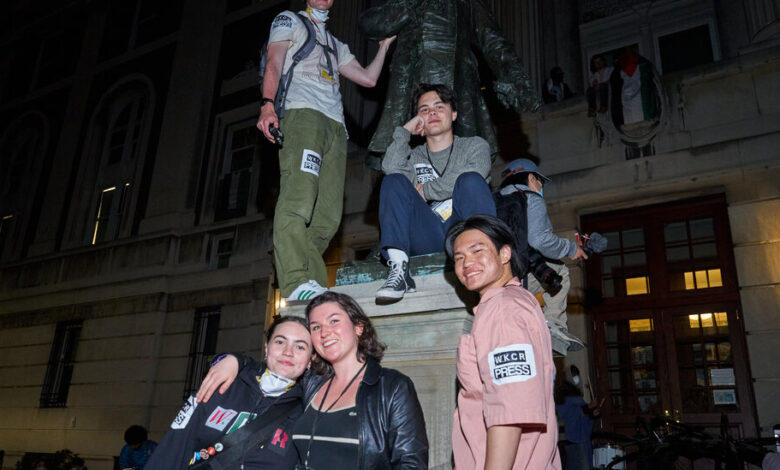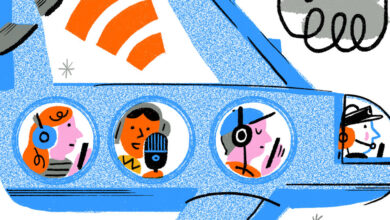Campus Protests Over Gaza Spotlight the Work of Student Journalists

Their updates come in harried bursts. Real-time narrations of the scene at Columbia University’s protest encampment in Manhattan, interspersed with the calmer voice of a host in the studio, directing live on air the dozen or so student journalists covering the moment police officers in riot gear moved in to clear an occupied university building Tuesday night.
“Do we have a field reporter over on Amsterdam? We have word that arrests are happening on Amsterdam, if we could get a field reporter over there.”
“Sorry, Sarah, do you need to go?”
“It’s getting really hard for us to report from this vantage.”
The stream from the Columbia University student-run radio station, WKCR, was so popular that night that its website crashed. As pro-Palestinian demonstrators seized Hamilton Hall, theirs was one of the most extensive broadcasts from the scene because the school had limited access for professional journalists.
The same is true around the country, where student journalists have provided some of the most detailed and riveting coverage of the protests that have engulfed campuses. The Brown Daily Herald reported on negotiations between the school’s trustee board and the protesters there. The University of Southern California’s paper, The Daily Trojan, Dartmouth College’s The Dartmouth and the University of North Carolina’s Daily Tar Heel have provided minute-by-minute live coverage on X, Instagram and on their websites.
The journalists’ efforts have drawn rare praise from the Pulitzer Prize Board, which highlighted in a statement the “extraordinary real-time reporting of student journalists at Columbia University” and around the country, who reported “under difficult and dangerous circumstances and at risk of arrest.”
At the University of California, Los Angeles, four student reporters were physically assaulted, according to the publication, The Daily Bruin, and The Los Angeles Times. The assaults happened after the student journalists were refused access to a university building by security officers, The Daily Bruin said.
The students have not gotten everything right. On Tuesday night, WKCR reported incorrectly that the New York Police Department was using tear gas as officers entered the building. The department has since said it did not use tear gas. The station has issued multiple clarifications on air.
Macyn Hanzlik-Barend, a junior at Columbia who helped coordinate coverage on Tuesday night, said the initial report was based on “smells” and a fire alarm going off inside Hamilton Hall.
But the overall coverage of the protests by student journalists has been widely lauded.
“What really distinguishes this story is they’re writing about their campus, their friends and, to a certain extent, themselves,” said Bill Grueskin, a professor at Columbia Journalism School.
Emmy Martin, the editor in chief of The Daily Tar Heel in North Carolina, said reporting on the protests had taken an emotional toll. On Tuesday, the police arrested protesters on the university’s main quad, which the paper covered and has left many of its journalists “still struggling to process a lot of it.”
“We’re journalists, but we’re also students,” Ms. Martin said. “Many of us have friends who are protesting. Many of us have friends who were arrested.”
Wednesday and Thursday were quieter for the students at WKCR. After concluding its coverage Tuesday night, the station said its reporters would take “some much-need physical and emotional recuperation.”
The roughly 20 student journalists who work there spent the first half of the week operating in shifts to ensure at least one person could staff the studio at all times. Some even slept in a secondary studio the station uses for live music recordings.
On Monday night, “I slept in the Butler Library for 30 minutes,” said Ian Pumphrey, a Columbia student who reported for the station Monday and Tuesday. “Then I went outside and continued my coverage.”
When asked whether he’d done any schoolwork this week, Mr. Pumphrey had a simple response.
“I mean, no.”



